康奈尔大学 5R 笔记法
康奈尔笔记案例及模板(5R笔记法模板)
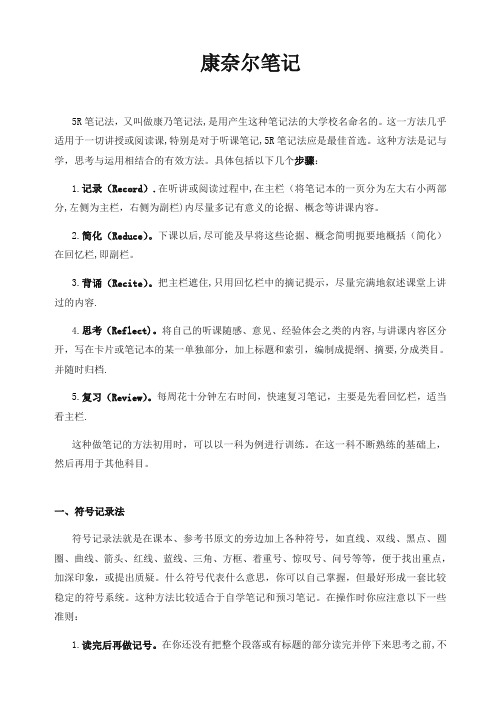
康奈尔笔记5R笔记法,又叫做康乃笔记法,是用产生这种笔记法的大学校名命名的。
这一方法几乎适用于一切讲授或阅读课,特别是对于听课笔记,5R笔记法应是最佳首选。
这种方法是记与学,思考与运用相结合的有效方法。
具体包括以下几个步骤:1.记录(Record).在听讲或阅读过程中,在主栏(将笔记本的一页分为左大右小两部分,左侧为主栏,右侧为副栏)内尽量多记有意义的论据、概念等讲课内容。
2.简化(Reduce)。
下课以后,尽可能及早将这些论据、概念简明扼要地概括(简化)在回忆栏,即副栏。
3.背诵(Recite)。
把主栏遮住,只用回忆栏中的摘记提示,尽量完满地叙述课堂上讲过的内容.4.思考(Reflect)。
将自己的听课随感、意见、经验体会之类的内容,与讲课内容区分开,写在卡片或笔记本的某一单独部分,加上标题和索引,编制成提纲、摘要,分成类目。
并随时归档.5.复习(Review)。
每周花十分钟左右时间,快速复习笔记,主要是先看回忆栏,适当看主栏.这种做笔记的方法初用时,可以以一科为例进行训练。
在这一科不断熟练的基础上,然后再用于其他科目。
一、符号记录法符号记录法就是在课本、参考书原文的旁边加上各种符号,如直线、双线、黑点、圆圈、曲线、箭头、红线、蓝线、三角、方框、着重号、惊叹号、问号等等,便于找出重点,加深印象,或提出质疑。
什么符号代表什么意思,你可以自己掌握,但最好形成一套比较稳定的符号系统。
这种方法比较适合于自学笔记和预习笔记。
在操作时你应注意以下一些准则:1.读完后再做记号。
在你还没有把整个段落或有标题的部分读完并停下来思考之前,不要在课本上做记号。
在阅读的时候,你要分清作者是在讲一个新的概念,还是只是用不同的词语说明同样的概念,你只有等读完这一段落或部分以后,才能回过头来看出那些重复的内容.这样做可使你不至于抓住那些一眼看上去仿佛很重要的东西。
2.要非常善于选择.你不要一下子在很多项目下划线或草草写上许多项目,这样会使记忆负担过重,并迫使你同一时刻从几个方面来思考问题,也加重你的思维负担。
商康奈尔大学做笔记的方法

康奈尔大学做笔记的方法,从此学习工作效率提高100%5R笔记法,又叫做康乃笔记法,是用产生这种笔记法的大学校名命名的。
这一方法几乎适用于一切讲授或阅读课,特别是对于听课笔记,5R笔记法应是最佳首选。
这种方法是记与学,思考与运用相结合的有效方法。
具体包括以下几个步骤:1.记录(Record)。
在听讲或阅读过程中,在主栏(将笔记本的一页分为左大右小两部分,左侧为主栏,右侧为副栏)内尽量多记有意义的论据、概念等讲课内容。
2.简化(Reduce)。
下课以后,尽可能及早将这些论据、概念简明扼要地概括(简化)在回忆栏,即副栏。
3.背诵(Recite)。
把主栏遮住,只用回忆栏中的摘记提示,尽量完满地叙述课堂上讲过的内容。
4.思考(Reflect)。
将自己的听课随感、意见、经验体会之类的内容,与讲课内容区分开,写在卡片或笔记本的某一单独部分,加上标题和索引,编制成提纲、摘要,分成类目。
并随时归档。
5.复习(Review)每周花十分钟左右时间,快速复习笔记,主要是先看回忆栏,适当看主栏。
这种做笔记的方法初用时,可以以一科为例进行训练。
在这一科不断熟练的基础上,然后再用于其他科目。
二、符号记录法符号记录法就是在课本、参考书原文的旁边加上各种符号,如直线、双线、黑点、圆圈、曲线、箭头、红线、蓝线、三角、方框、着重号、惊叹号、问号等等,便于找出重点,加深印象,或提出质疑。
什么符号代表什么意思,你可以自己掌握,但最好形成一套比较稳定的符号系统。
这种方法比较适合于自学笔记和预习笔记。
在操作时你应注意以下一些准则:1.读完后再做记号。
在你还没有把整个段落或有标题的部分读完并停下来思考之前,不要在课本上做记号。
在阅读的时候,你要分清作者是在讲一个新的概念,还是只是用不同的词语说明同样的概念,你只有等读完这一段落或部分以后,才能回过头来看出那些重复的内容。
这样做可使你不至于抓住那些一眼看上去仿佛很重要的东西。
2.要非常善于选择。
康奈尔大学做笔记法(有图)
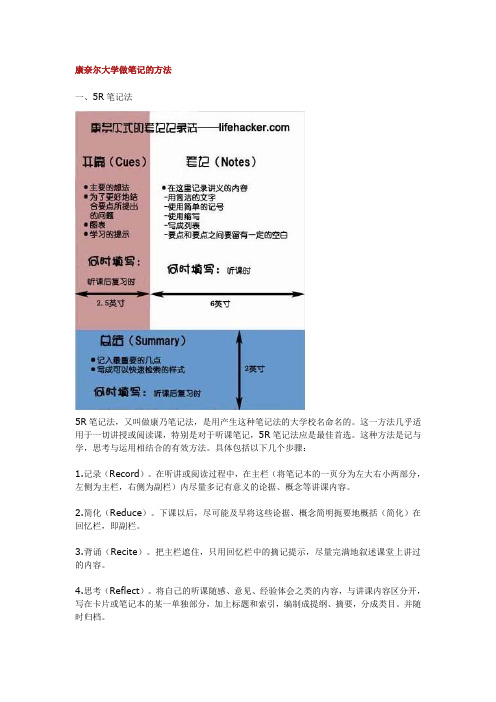
康奈尔大学做笔记的方法一、5R笔记法5R笔记法,又叫做康乃笔记法,是用产生这种笔记法的大学校名命名的。
这一方法几乎适用于一切讲授或阅读课,特别是对于听课笔记,5R笔记法应是最佳首选。
这种方法是记与学,思考与运用相结合的有效方法。
具体包括以下几个步骤:1.记录(Record)。
在听讲或阅读过程中,在主栏(将笔记本的一页分为左大右小两部分,左侧为主栏,右侧为副栏)内尽量多记有意义的论据、概念等讲课内容。
2.简化(Reduce)。
下课以后,尽可能及早将这些论据、概念简明扼要地概括(简化)在回忆栏,即副栏。
3.背诵(Recite)。
把主栏遮住,只用回忆栏中的摘记提示,尽量完满地叙述课堂上讲过的内容。
4.思考(Reflect)。
将自己的听课随感、意见、经验体会之类的内容,与讲课内容区分开,写在卡片或笔记本的某一单独部分,加上标题和索引,编制成提纲、摘要,分成类目。
并随时归档。
5.复习(Review)每周花十分钟左右时间,快速复习笔记,主要是先看回忆栏,适当看主栏。
这种做笔记的方法初用时,可以以一科为例进行训练。
在这一科不断熟练的基础上,然后再用于其他科目。
二、符号记录法符号记录法就是在课本、参考书原文的旁边加上各种符号,如直线、双线、黑点、圆圈、曲线、箭头、红线、蓝线、三角、方框、着重号、惊叹号、问号等等,便于找出重点,加深印象,或提出质疑。
什么符号代表什么意思,你可以自己掌握,但最好形成一套比较稳定的符号系统。
这种方法比较适合于自学笔记和预习笔记。
在操作时你应注意以下一些准则:1.读完后再做记号。
在你还没有把整个段落或有标题的部分读完并停下来思考之前,不要在课本上做记号。
在阅读的时候,你要分清作者是在讲一个新的概念,还是只是用不同的词语说明同样的概念,你只有等读完这一段落或部分以后,才能回过头来看出那些重复的内容。
这样做可使你不至于抓住那些一眼看上去仿佛很重要的东西。
2.要非常善于选择。
你不要一下子在很多项目下划线或草草写上许多项目,这样会使记忆负担过重,并迫使你同一时刻从几个方面来思考问题,也加重你的思维负担。
★康奈笔记法(史上最科学的记笔记方法)

一、5R笔记法5R笔记法,又叫做康乃笔记法,是用产生这种笔记法的大学校名命名的。
这一方法几乎适用于一切讲授或阅读课,特别是对于听课笔记,5R笔记法应是最佳首选。
这种方法是记与学,思考与运用相结合的有效方法。
具体包括以下几个步骤:1.记录(Record)。
在听讲或阅读过程中,在主栏(将笔记本的一页分为左大右小两部分,左侧为主栏,右侧为副栏)内尽量多记有意义的论据、概念等讲课内容。
2.简化(Reduce)。
下课以后,尽可能及早将这些论据、概念简明扼要地概括(简化)在回忆栏,即副栏。
3.背诵(Recite)。
把主栏遮住,只用回忆栏中的摘记提示,尽量完满地叙述课堂上讲过的内容。
4.思考(Reflect)。
将自己的听课随感、意见、经验体会之类的内容,与讲课内容区分开,写在卡片或笔记本的某一单独部分,加上标题和索引,编制成提纲、摘要,分成类目。
并随时归档。
5.复习(Review)每周花十分钟左右时间,快速复习笔记,主要是先看回忆栏,适当看主栏。
这种做笔记的方法初用时,可以以一科为例进行训练。
在这一科不断熟练的基础上,然后再用于其他科目。
二、符号记录法符号记录法就是在课本、参考书原文的旁边加上各种符号,如直线、双线、黑点、圆圈、曲线、箭头、红线、蓝线、三角、方框、着重号、惊叹号、问号等等,便于找出重点,加深印象,或提出质疑。
什么符号代表什么意思,你可以自己掌握,但最好形成一套比较稳定的符号系统。
这种方法比较适合于自学笔记和预习笔记。
在操作时你应注意以下一些准则:1.读完后再做记号。
在你还没有把整个段落或有标题的部分读完并停下来思考之前,不要在课本上做记号。
在阅读的时候,你要分清作者是在讲一个新的概念,还是只是用不同的词语说明同样的概念,你只有等读完这一段落或部分以后,才能回过头来看出那些重复的内容。
这样做可使你不至于抓住那些一眼看上去仿佛很重要的东西。
2.要非常善于选择。
你不要一下子在很多项目下划线或草草写上许多项目,这样会使记忆负担过重,并迫使你同一时刻从几个方面来思考问题,也加重你的思维负担。
康奈尔笔记法详解

康奈尔笔记法详解
康奈尔笔记法之所以叫做5R笔记法,因为它分为五步,R取自于每一步的英文单词开头一个字母。
第一步是记录,就是把课堂上的内容、知识点记在本子上,但在记录之前还需要要比较进行分栏,分成左小右大两类,而主要的概念知识点记在右侧。
第二步是简化,这一步要在课后去完成,要求大家课后整理笔记,提炼要点,放在左侧栏里,形成一一对应关系。
第三步是背诵,根据自己整理的简化栏里的内容去背知识点,相当于看提纲回忆本章节所学内容。
第四步是思考,随时将自己的所思所感所想整理出来,以及自己的做题经验、体会等单独放在一个位置,随时归纳出来,方便自己日后学习。
第五步是复习,一周抽十分钟看笔记,从头把知识再复习一遍,以便于更好的做题。
康奈尔笔记法只是众多记笔记方法中的一个,它有自己的体系,有成型的方案,但是有些学生不习惯与用这种方式去记笔记,嫌它太过麻烦。
当然,每个人的看法是不同的,要想在以后的复习过程中节省时间、效率更高,那么在做笔记上就要花费更多的时间,把比较做的更耐看,更有实用价值。
除了这种记笔记方法,还有十余种记笔记的方式,同学们可以多了解一下,找出几种最适合自己的,然后尽量提高记笔记的效率。
不
仅把笔记写的又快又好,还要让笔记发挥出更大的价值,提高我们的学习效率,这才是最终的目的。
没有一种学习方法是终身实用的,也没有一种学习方法是适合所有人的。
同样,康奈尔笔记法也要辩证的去看,适合自己就可以去用,不习惯就弃用,不要有任何的疑虑。
5R笔记法(康奈尔大学做笔记的方法)【范本模板】
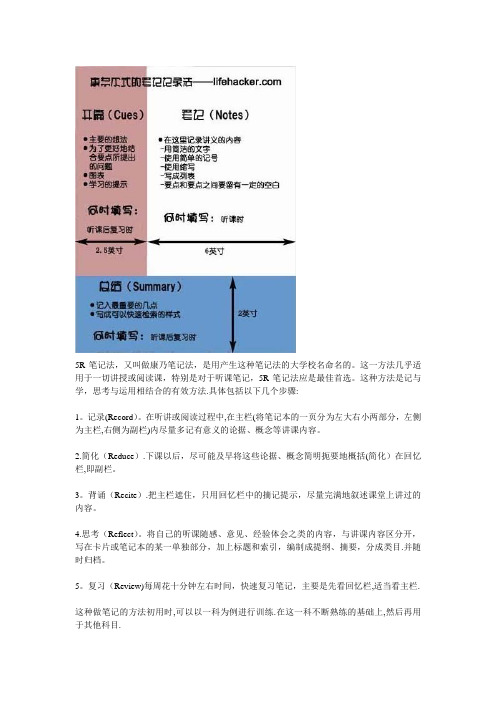
5R笔记法,又叫做康乃笔记法,是用产生这种笔记法的大学校名命名的。
这一方法几乎适用于一切讲授或阅读课,特别是对于听课笔记,5R笔记法应是最佳首选。
这种方法是记与学,思考与运用相结合的有效方法.具体包括以下几个步骤:1。
记录(Record)。
在听讲或阅读过程中,在主栏(将笔记本的一页分为左大右小两部分,左侧为主栏,右侧为副栏)内尽量多记有意义的论据、概念等讲课内容。
2.简化(Reduce).下课以后,尽可能及早将这些论据、概念简明扼要地概括(简化)在回忆栏,即副栏。
3。
背诵(Recite).把主栏遮住,只用回忆栏中的摘记提示,尽量完满地叙述课堂上讲过的内容。
4.思考(Reflect)。
将自己的听课随感、意见、经验体会之类的内容,与讲课内容区分开,写在卡片或笔记本的某一单独部分,加上标题和索引,编制成提纲、摘要,分成类目.并随时归档。
5。
复习(Review)每周花十分钟左右时间,快速复习笔记,主要是先看回忆栏,适当看主栏.这种做笔记的方法初用时,可以以一科为例进行训练.在这一科不断熟练的基础上,然后再用于其他科目.二、符号记录法符号记录法就是在课本、参考书原文的旁边加上各种符号,如直线、双线、黑点、圆圈、曲线、箭头、红线、蓝线、三角、方框、着重号、惊叹号、问号等等,便于找出重点,加深印象,或提出质疑。
什么符号代表什么意思,你可以自己掌握,但最好形成一套比较稳定的符号系统。
这种方法比较适合于自学笔记和预习笔记.在操作时你应注意以下一些准则:1.读完后再做记号。
在你还没有把整个段落或有标题的部分读完并停下来思考之前,不要在课本上做记号。
在阅读的时候,你要分清作者是在讲一个新的概念,还是只是用不同的词语说明同样的概念,你只有等读完这一段落或部分以后,才能回过头来看出那些重复的内容.这样做可使你不至于抓住那些一眼看上去仿佛很重要的东西。
2.要非常善于选择。
你不要一下子在很多项目下划线或草草写上许多项目,这样会使记忆负担过重,并迫使你同一时刻从几个方面来思考问题,也加重你的思维负担。
康奈尔大学做笔记的方法(中文版)

康奈尔大学做笔记的方法,从此学习工作效率提高100%Thu Jun 28 15:28:56 20125R笔记法,又叫做康乃笔记法,是用产生这种笔记法的大学校名命名的。
这一方法几乎适用于一切讲授或阅读课,特别是对于听课笔记,5R笔记法应是最佳首选。
这种方法是记与学,思考与运用相结合的有效方法。
具体包括以下几个步骤:1.记录(Record)。
在听讲或阅读过程中,在主栏(将笔记本的一页分为左大右小两部分,左侧为主栏,右侧为副栏)内尽量多记有意义的论据、概念等讲课内容。
2.简化(Reduce)。
下课以后,尽可能及早将这些论据、概念简明扼要地概括(简化)在回忆栏,即副栏。
3.背诵(Recite)。
把主栏遮住,只用回忆栏中的摘记提示,尽量完满地叙述课堂上讲过的内容。
4.思考(Reflect)。
将自己的听课随感、意见、经验体会之类的内容,与讲课内容区分开,写在卡片或笔记本的某一单独部分,加上标题和索引,编制成提纲、摘要,分成类目。
并随时归档。
5.复习(Review)每周花十分钟左右时间,快速复习笔记,主要是先看回忆栏,适当看主栏。
这种做笔记的方法初用时,可以以一科为例进行训练。
在这一科不断熟练的基础上,然后再用于其他科目。
二、符号记录法符号记录法就是在课本、参考书原文的旁边加上各种符号,如直线、双线、黑点、圆圈、曲线、箭头、红线、蓝线、三角、方框、着重号、惊叹号、问号等等,便于找出重点,加深印象,或提出质疑。
什么符号代表什么意思,你可以自己掌握,但最好形成一套比较稳定的符号系统。
这种方法比较适合于自学笔记和预习笔记。
在操作时你应注意以下一些准则:1.读完后再做记号。
在你还没有把整个段落或有标题的部分读完并停下来思考之前,不要在课本上做记号。
在阅读的时候,你要分清作者是在讲一个新的概念,还是只是用不同的词语说明同样的概念,你只有等读完这一段落或部分以后,才能回过头来看出那些重复的内容。
这样做可使你不至于抓住那些一眼看上去仿佛很重要的东西。
康奈尔大学做笔记的方法_及多种笔记方法中文简体

右栏:课堂的笔记(标出重点;轮廓做好)之公保含烟创作左栏:总结(用年夜括号括着右边的内容);为了却合要点所提出的问题;总结的图表下面:关键词(重要的点,用一种颜色的笔写TOP);自己的感想和经历(BOTTOM)只记载一页,空白一页;一章事先或几章事先,空白一页画一个各个概念间关系图表,然后以后看图表,关键词,笔记的方式来温习一、5R笔记法5R笔记法,又叫做康乃笔记法,是用发作这种笔记法的年夜学校名命名的.这一办法简直适用于一切讲授或阅读课,特别是关于听课笔记,5R笔记法应是最佳首选.这种办法是记与学,思考与运用相结合的有效办法.详细包括以下几个步伐:1.记载(Record).在听讲或阅读进程中,在主栏(将笔记本的一页分为左年夜右小两局部,左侧为主栏,右侧为副栏)内尽量多记有意义的论据、概念等讲课内容.2.简化(Reduce).下课以后,尽能够及早将这些论据、概念长篇年夜论地概括(简化)在回想栏,即副栏.3.背诵(Recite).把主栏遮住,只用回想栏中的摘记提示,尽量完满地叙述课堂上讲过的内容.4.思考(Reflect).将自己的听课随感、意见、经历体会之类的内容,与讲课内容区分开,写在卡片或笔记本的某一独自局部,加上题目和索引,编制成提纲、摘要,分红类目.并随时归档.5.温习(Review)每周花十分钟左右时间,疾速温习笔记,主要是先看回想栏,适当看主栏.这种做笔记的办法初用时,可以以一科为例停止训练.在这一科不竭熟练的根底上,然后再用于其他科目.二、符号记载法符号记载法就是在课本、参考书原文的旁边加上各种符号,如直线、双线、黑点、圆圈、曲线、箭头、红线、蓝线、三角、方框、着重号、惊叹号、问号等等,便于找出重点,加深印象,或提出质疑.什幺符号代表什幺意思,你可以自己掌握,但最好形成一套比拟稳定的符号系统.这种办法比拟适合于自学笔记和预习笔记.在操作时你应注意以下一些准则:1.读完后再做记号.在你还没有把整个段落或有题目的局部读完并停下来思考之前,不要在课本上做记号.在阅读的时候,你要分清作者是在讲一个新的概念,还是只是用分歧的词语说明同样的概念,你只有等读完这一段落或局部以后,才华回过头来看出那些重复的内容.这样做可使你不至于抓住那些一眼看上去似乎很重要的东西.2.要十分善于选择.你不要一下子在很多项目下划线或草草写上许多项目,这样会使记忆担负过重,并迫使你同一时刻从几个方面来思考问题,也减轻你的思维担负.你要少做些记号,但也不要少得使你在温习时又只好将整页内容通读一遍.3.用自己的话.页边空白处冗长的笔记应该用你自己的话来写,这是因为自己的话代表你自己的思想,以后这些话会成为这一页所述概念的一些有力的提示.4.简洁.在一些虽冗长然则有意义的短语下划线,而不要在完整的句子下面划线,页边空白处的笔记要长篇年夜论.它们会在你的记忆里留下更为深刻的印象.在你背诵和温习的时候用起来更可随心所欲.5.迅速.你不成能一整天的时间都用来做记号.你先要阅读,再回过头来年夜概地温习一遍,并迅速做下记号,然后学习这一章的下一局部外容.6.整齐.你作的符号要尽量整齐,而不要胡写乱画,否则会影响你以后的温习和应运.当你以后温习的时候,整齐的记号会鼓舞你不竭学习,并可以节省时间,因为整齐的记号便于你迅速回想现在学习时的情景,能使你容易而清楚地领悟书中的思想.三、笔记整理法由于种种原因,你在课堂上做的笔记往往比拟杂乱,课后温习不太好用.为了稳固学习效果,积聚温习资料,你需要对笔记进一步整理,使之成为比拟系统、条理的参考资料.对课堂笔记停止整理、加工的办法是:1.忆.课后即抓紧时间,一气呵成,对照书本、笔记,及时回想有关信息.这是你整理笔记的重要前提.2.补.课堂上所作的笔记,因为是跟着教员讲课的速度停止的,而讲课速度要比记载速度快一些,所以你的笔记会呈现缺漏、跳跃、省略等情况,在忆的根底上,及时作修补,使笔记更完整.3.改.仔细审阅你的课堂笔记,对错字、错句及其他不足确切的中央停止修改.4.编.用统一的序号,对笔记内容停止提纲式的、逻辑性的排列,注明号码,梳理好整理笔记的先后顺序.5.分.以文字(最好用色笔)或符号、代号等划分笔记内容的类别.例如:哪些是字词类,哪些是作家与作品类,哪些作品(或课文)剖析类,哪些是问题质疑、探索类,哪些是课后练习题解答等等.6.舍.省略无关紧要的笔记内容,使笔记长篇年夜论.7.记.分类缮写经过整理的笔记.同类的知识,摘抄在同一个簿子上或一个簿子的同一局部,也可以用卡片分类缮写.这样,日后温习、使用就方便了,按需所取,纲目清晰,快捷好用,便于记忆.SQ3R读书法与康乃尔笔记法阅读:一、翻阅目录,将章节纲要阅读一遍.二、疾速阅读导言与摘要.三、阅读主要图表.四、阅读主题目与副题目.提问:一、把书阖上,问自己「作者想表达的重要观念为何?」,可依据阅读的印象答复,让自己有清楚的架构.二、翻开书,将第一句的题目酿成问句,并写在题目旁,以激起好奇心与了解力.三、在每个题目都如此做.阅读:一、详阅每章节,并试着答复题目旁所提的问题.二、标出关键字句,帮助自己温习时容易了解与回想.三、在课本空白处,写下重要观念的摘要.四、在最能够出题的中央做记号.五、阅读不是主动接受,可以主动搜寻谜底.演练:一、阅读完一章节后,把书阖起来,练习答复写在题目旁的问题.二、答复时尽量用自己的语言,并试着举出例子来.三、在脑海里记下一些关键句或语词.温习:一、读完整章节并做重要记号后,把书中重点重新看一遍.藉以了解此章的重要观念及其中关联.二、试着回想或写下主题目下的副题目,反省是否记得此章内容.三、用纸或书盖住此章节,试着回想此章节重点.四、拿开书或纸,对照看和书上写的是否一致.康乃尔笔记法分为上课时记笔记、整理、演练及温习等四年夜步伐. 上课时记笔记:一、用年夜张活页笔记本,在间隔左边六公分处画一条垂直线.在线的右边记下上课的重要内容.二、对重覆呈现的字或片语,以代号或简写替代.三、只用笔记纸的其中一面.四、在另一主题开端前,留下空白让自己了解这是另一主题的开端.整理:一、上课后尽快将简写拼凑完整.二、图表画清楚.三、新词和重要句子旁画线.四、以星号或惊叹号标出重点.五、修订错别字.六、直线左边栏位为温习栏,将右边上课整理完后在此写下关键字或词、冗长题目、重要观念摘要并加上注解.演练:用手盖住右边笔记,只看左边练习栏内容,问自己问题并能够年夜声说出记得的笔记内容,之后拿开手对照谜底是否完整.温习:多做几次自问自答,每次时间不要太长,短但屡次的温习效果较佳.一定要学的笔记读书办法: 康乃尔笔记法-笔记术十招1. 康乃尔笔记法此笔记法源自于美国康乃尔年夜学,故名为「康乃尔笔记法」(Cornell Method).它融合了课堂与课后笔记,同学不单可因此免于重誊上课笔记的时间,还可以应用笔记做更有效率的温习.● 上课时笔记建议同学可以使用年夜张活页纸(A4以上)来做笔记,在纸张左侧约六公分处画一条垂直线,将课堂笔记缮写在线的右边,此栏称为「笔记栏」,而线的左边则称为「温习栏」.由于一般人写字速度比教员讲课速度慢,因此上课时,同学可以用条列式或关键字方式,将重点浓缩缮写于笔记栏,如重年夜事件、进程、定义,以及有助于了解主题的细节.在此要注意的是,建议同学只用单面纸张缮写笔记,而纸张的另一面则留待以后温习时,做其他资料弥补和表格整理;另外,为方便以后弥补相关资料,在完毕一个章节或单位后,建议换另一张空白纸,再持续缮写.● 整理「笔记栏」,运用「温习栏」课后,应尽速将「笔记栏」做最后修饰,简写的文字拼凑完整,并修订错字、填补语意不明处,同时将图表画清楚,或在新名词和重要句子下画线强调、用星号标识表记标帜等,将重点标示出来,以使课堂笔记更加完整.温习时,可应用直线左边的栏位整理、融会课程内容,亦即在吸收「笔记栏」的重点后,于「温习栏」写下关键字词、冗长题目、重要摘要等.如此不单能增强你对上课内容的印象,还可作为温习时有效掌握重点精髓的纲要.2. 关键字笔记法此法又称为「左脑式关键字笔记法」,作法是在笔记纸的右侧约四分之一处画一条重直线,将线的左边称为「笔记区」,线的右边称为「关键字区」.用平时习用的书写方式在「笔记区」内做笔记,再从中选个关键字誊进右边的「关键字区」.举例来说,在研读历史的「宋代官制」时,可以在「笔记区」辨别记载下中书省、枢密院、三司的职责及要点,在「关键字区」则抓出如「中书省:行政」、「枢密院:军政」、「三司:财政」等的关键字. 然后依循「康乃尔笔记法」演练及温习步伐,应用关键字回忆「笔记区」内容来记忆.建议同学在整理过「关键字区」后,无妨找出关键字之间的关系,将文字绘成图表,然后应用图表进行重点串联,树立起一个有组织的架构,最后再以「图像→ 关键字→笔记区」的记忆步伐回忆课程内容.3. 便利贴笔记法读书就是要将所学内容牢牢记住,其中自然少不了必需反覆训练,但这并不是意味着要正经八百的坐在书桌前反覆学习,因为缺乏新鲜安慰的延续记忆过久,记忆力是会逐渐下降的哟.所以同学在读书时,应当安插一些适当的休息时间,然后应用这些时间,透过其他管道学习.例如在书房做个小型看板或留言板,然后将平时读书的重点或无法了解的章节与问题,以便利贴记载在板上,当你站起来伸懒腰休息时,或可顺便「不小心」瞄到这些「精髓重点」,事先以较轻松的心情思索这些问题时,说不定因心情抓紧了,突然灵光乍现,也许许多平日难以体会、了解的内容,一下子就恍然年夜悟了呢!当然,这些便利贴也可以贴在自己平时较常收支或较为显眼的中央,例如客厅或房间门板、冰箱门、鞋柜、电脑萤幕,甚至洗手间等,都可以让同学随时随地学习,增加课程印象,增强读书效果,所以此法也叫做「四面八方笔记法」.4. 卡式问题集法卡式问题集法即是在卡片正面缮写问题,背面再记下该问题纲领式的重点提示和谜底,这种作法既简便又省时,对增进记忆也很有帮助.例如数文科中解不出来的难题,或英文的佳句、片语,以及历史年代表、天文等高线图、生物组织图等,就十分适合做成卡式问题集.利用此笔记法的益处是方便阅读,一张一张的小卡片,方便携带,随可读,而读懂了的卡片可以抽出另外放,从剩下的卡片中,可以了解自己还有多少不会的,以追踪读书进度.另外,还可以用随机抽取的方式来阅读(有点像抽取算命的塔罗牌一样),较富趣味,属于较轻松的笔记阅读方式. 5. 书本注记法有时同学会发现许多重点虽然呈现在分歧的章节,但彼此之间的内容却有着关联性或一贯性,例如读到高中历史第四册第一章「近代民主政治的发靭」、第三章「近代民主政治的停顿」时,辨别提到英国的民主开展进程,因此当同学读到第三章时,就可在书本上复杂注记「参考第xx页」,以免时间一久,课文内容无法衔接;或是应用书本空白处,制作较详细的比拟表,如此一来,同学对英国民主政治的开展将有更完整的概念,不单可以让记忆清晰、历久不衰,未来温习时就能省下很多宝贵的时间.以上的「书本注记法」所能应用的空间终究有限,有时还需要配合「书本剪贴法」才华将课本真正化成内容丰厚的笔记本.剪贴的内容包括:1.自己制作的统整图表.2.参考书或教员提供的相关课外资料.3.从报章杂志上剪下来与课内有关的资料或图片.课本的目录,其实就是课文的条列式重点,所欠缺的是这些年夜、小题目之下的因果说明或重点描述.因此,如果同学懒得自己抓重点来做笔记,那么可以将课本的目录影印下来,只要在空白处弥补重点说明,便成了最佳的纲要笔记囉!8. 透明纸笔记法这种笔记法特别适用于英文、国文或化学科,例如读到国文文言文时,作者生平、字词解释与课文是分开的,课文行间的空白处若写了字词解释,就无法再写翻译或其他相关弥补了,这时「透明纸笔记法」就能派上用场了.用这种笔记法还有另一个益处,就是在背英文单字、片语时,可以在透明纸上,将需要记忆的字词局部,以2B 铅笔涂黑,以安慰自己去默记(如图3).而透明纸最年夜的优点则是能够重覆应用,等背熟单字、片语后,再将涂黑之处擦去,又可再作应用啦!此外,若平常笔记时,将重点以蓝或白色笔书写,等温习时再以同色玻璃纸掩盖上去,那么就看不见「重点」了,正好可藉此检验自己的记忆功夫.Part2立异笔记术此地方谓的「立异笔记术」,泛指分歧于传统的行列式笔记或视觉型笔记.以下特罗列二种笔记法供同学参考:一般人做笔记的习惯,是以条列方式一行一行摘录重点,然而依据专家意见,这种办法其实不契合人脑的记忆,因为依头脑运作的原理,人是以树枝状连结法贮存资讯,因此有人便开展出「心智绘图笔记法」,以求增加记忆的保管量.「心智绘图」(Mind Mapping),又称为「心智图」(Mind Maps),是英国着名的教育学与心思学家汤尼.布桑(Tony Buzan),结合了心理学、神经生理学、语言学、神经语言学、资讯管理、记忆技巧、了解力与创意思考等的多种知识,并经过多年研究与实务经历后,所创造的一种崭新的观念与技巧.这种笔记法最近在补教界十分流行,且目前已有一百三十多个国度及二千多家企业,采用此法训练员工.此笔记法的主要概念是将人脑比如为一座宏年夜的森林,外面种植着千万株的树,每棵树再由枝干长出枝叶.因此,心智绘图应用这种原理和构造,由一个主题分出许多子题,将讯息贮藏在子题内.这种笔记法不只记录了许多讯息,更能从中了解各讯息间的关系,同时也能帮助同学以整体的角度来检视问题,增加了思考的灵敏度.「心智绘图笔记法」的原理如下: 1.将一个单位的主题放在正中央,当做中心理念.2.使用「关键字」──运用关键动词或名词当「key word」. 3.由中心主题向外扩张出副主题.4.每个副主题都有几个主要分枝. 5.每个概念都是用一个字词来表达.6.每个概念尽能够附上图片. 7.多使用符号、颜色、文字、图画和其他形象,使其多彩多姿,或增加地图的多样性,以增强印象.10. 录音笔记法人的记忆年夜致可分为视觉型与听觉型.视觉型的人擅用眼睛看过而加以记忆;听觉型的人擅用耳朵听过而加以记忆.如果你是属于听觉型记忆效果较佳的人,就可以应用「录音记忆法」来做笔记. 一般而言,以记忆性的科目或数学、物理、化学等需要背诵的公式定理(不含计算)和根本定义较适合采用录音笔记法,而文科的各种实验目的、进程、后果,也可以检验考试看看此法.录音的内容可以是教员的课堂解说,也可以自行制作.录教员的上课内容,优点是可将课堂上没听懂的局部,应用课余时间好好温习,有助于课程了解;缺点是事后温习也要破费同样多的时间来听,因此可以选择性录音,例如上课内容较紧凑或自己较弱的科目时,就值得使用此法.另外,当教员在年夜范围重点复习时,也是制作录音笔记的好时机.至于自行录制录音笔记时,应先将预录的内容至少精读一遍以上,然后将其中的重点对着录音设备念出来即可.录音笔记制作完成后,当然就要灵敏运用了,例如乘车时,车内光线缺乏、车身摇晃、人潮拥挤而不适合看书,只要拿出随身听就可以掌控时机随时随地学习喔.另外,睡觉前、起床后、走路时,或许眼睛疲劳时,这些较利于听觉学习的时段,也都是使用录音笔的好时机唷!。
5R笔记法(康奈尔大学做笔记的方法)

5R笔记法,又叫做康乃笔记法,是用产生这种笔记法的大学校名命名的.这一方法几乎适用于一切讲授或阅读课,特别是对于听课笔记,5R笔记法应是最佳首选。
这种方法是记与学,思考与运用相结合的有效方法.具体包括以下几个步骤:1。
记录(Record)。
在听讲或阅读过程中,在主栏(将笔记本的一页分为左大右小两部分,左侧为主栏,右侧为副栏)内尽量多记有意义的论据、概念等讲课内容。
2。
简化(Reduce)。
下课以后,尽可能及早将这些论据、概念简明扼要地概括(简化)在回忆栏,即副栏。
3。
背诵(Recite)。
把主栏遮住,只用回忆栏中的摘记提示,尽量完满地叙述课堂上讲过的内容。
4。
思考(Reflect)。
将自己的听课随感、意见、经验体会之类的内容,与讲课内容区分开,写在卡片或笔记本的某一单独部分,加上标题和索引,编制成提纲、摘要,分成类目。
并随时归档。
5。
复习(Review)每周花十分钟左右时间,快速复习笔记,主要是先看回忆栏,适当看主栏。
这种做笔记的方法初用时,可以以一科为例进行训练。
在这一科不断熟练的基础上,然后再用于其他科目。
二、符号记录法符号记录法就是在课本、参考书原文的旁边加上各种符号,如直线、双线、黑点、圆圈、曲线、箭头、红线、蓝线、三角、方框、着重号、惊叹号、问号等等,便于找出重点,加深印象,或提出质疑。
什么符号代表什么意思,你可以自己掌握,但最好形成一套比较稳定的符号系统。
这种方法比较适合于自学笔记和预习笔记。
在操作时你应注意以下一些准则:1.读完后再做记号。
在你还没有把整个段落或有标题的部分读完并停下来思考之前,不要在课本上做记号.在阅读的时候,你要分清作者是在讲一个新的概念,还是只是用不同的词语说明同样的概念,你只有等读完这一段落或部分以后,才能回过头来看出那些重复的内容。
这样做可使你不至于抓住那些一眼看上去仿佛很重要的东西。
2.要非常善于选择。
你不要一下子在很多项目下划线或草草写上许多项目,这样会使记忆负担过重,并迫使你同一时刻从几个方面来思考问题,也加重你的思维负担.你要少做些记号,但也不要少得使你在复习时又只好将整页内容通读一遍。
康奈尔大学做笔记的方法,从此学习工作效率提高
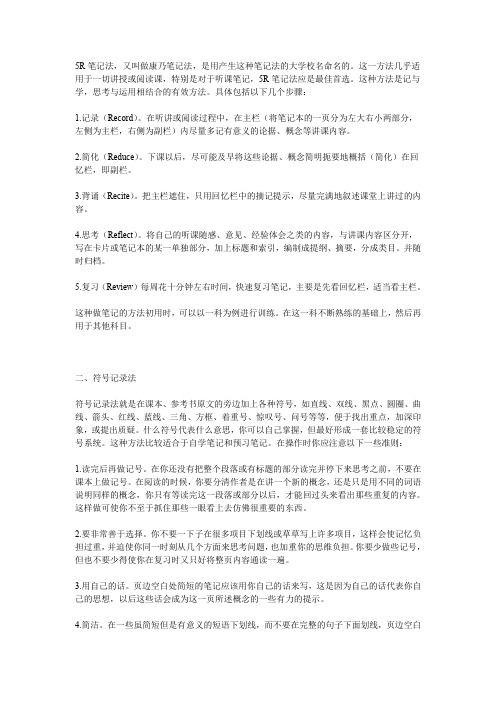
5R笔记法,又叫做康乃笔记法,是用产生这种笔记法的大学校名命名的。
这一方法几乎适用于一切讲授或阅读课,特别是对于听课笔记,5R笔记法应是最佳首选。
这种方法是记与学,思考与运用相结合的有效方法。
具体包括以下几个步骤:1.记录(Record)。
在听讲或阅读过程中,在主栏(将笔记本的一页分为左大右小两部分,左侧为主栏,右侧为副栏)内尽量多记有意义的论据、概念等讲课内容。
2.简化(Reduce)。
下课以后,尽可能及早将这些论据、概念简明扼要地概括(简化)在回忆栏,即副栏。
3.背诵(Recite)。
把主栏遮住,只用回忆栏中的摘记提示,尽量完满地叙述课堂上讲过的内容。
4.思考(Reflect)。
将自己的听课随感、意见、经验体会之类的内容,与讲课内容区分开,写在卡片或笔记本的某一单独部分,加上标题和索引,编制成提纲、摘要,分成类目。
并随时归档。
5.复习(Review)每周花十分钟左右时间,快速复习笔记,主要是先看回忆栏,适当看主栏。
这种做笔记的方法初用时,可以以一科为例进行训练。
在这一科不断熟练的基础上,然后再用于其他科目。
二、符号记录法符号记录法就是在课本、参考书原文的旁边加上各种符号,如直线、双线、黑点、圆圈、曲线、箭头、红线、蓝线、三角、方框、着重号、惊叹号、问号等等,便于找出重点,加深印象,或提出质疑。
什么符号代表什么意思,你可以自己掌握,但最好形成一套比较稳定的符号系统。
这种方法比较适合于自学笔记和预习笔记。
在操作时你应注意以下一些准则:1.读完后再做记号。
在你还没有把整个段落或有标题的部分读完并停下来思考之前,不要在课本上做记号。
在阅读的时候,你要分清作者是在讲一个新的概念,还是只是用不同的词语说明同样的概念,你只有等读完这一段落或部分以后,才能回过头来看出那些重复的内容。
这样做可使你不至于抓住那些一眼看上去仿佛很重要的东西。
2.要非常善于选择。
你不要一下子在很多项目下划线或草草写上许多项目,这样会使记忆负担过重,并迫使你同一时刻从几个方面来思考问题,也加重你的思维负担。
康奈尔大学5R笔记法

康奈尔大学5R笔记法一、5R笔记法5R笔记法,又叫做康乃笔记法,是记与学、思与用相结合的方法,分三步:1.记录(Record)。
听讲时,笔记本左侧为主栏,右侧为副栏,主栏里尽量多记有意义的论据、概念等讲课内容。
2.简化(Reduce)。
下课后,尽可能及时将论据、概念简明扼要地概括在副栏。
3.背诵(Recite)。
睡前,把主栏遮住只用副栏摘记提示,尽量完满地叙述主栏的内容。
4.思考(Reflect)。
平时,将随感写下,做成笔记的一部分(可单独保管)。
5.复习(Review)每周10分钟,快速复习笔记,主要是先看回忆栏,适当看主栏。
二、符号记录法用直线、双线、黑点、圆圈、曲线、箭头、红线、蓝线、三角、方框、着重号、惊叹号、问号等等,便于找出重点,加深印象,或提出质疑。
什么符号代表什么意思,最好形成一套比较稳定的符号系统:1.读完后再做记号。
回过头来第二次读书是才能看出那些重复的内容。
第一眼看上去仿佛很重要的东西新,但有时不是关键。
2.要非常善于选择。
不会使记忆负担过重,考前或演讲前只要将要点通读一遍即可。
3.用自己的话。
代表自己的思想,以后用这些概念时会是有力的提示。
4.简洁。
只在一些有意义的短语下划线,页边空白处的笔记要简明扼要,背诵和复习时用起来更可得心应手。
5.迅速。
先大略翻阅一下,回过头来发现重点,并迅速做下记号。
6.整齐。
不要胡写乱画,否则会影响你以后的复习和应运。
三、笔记整理法1.忆。
课后抓紧时间,趁热打铁,对照书本、笔记、回忆进行整理。
2.补。
课堂上所作的笔记,讲课时老师讲和自己记都会出现缺漏,要及时修补,使笔记完整。
3.改。
对错及不确切的地方进行修改。
4.编。
对笔记进行提纲式、逻辑性排列,注明号码。
5.分。
以文字(最好用色笔)或符号、代号等划分笔记内容的类别。
6.舍。
省略无关紧要的,使笔记简明。
7.记。
分类抄录经过整理的笔记,快捷好用,便于记忆。
【快速记忆法】5R课堂笔记法(康奈尔笔记法)

【快速记忆法】5R课堂笔记法(康奈尔笔记法)一:5r笔记法,又叫做康乃笔记法,是用产生这种笔记法的大学校名命名的。
这种方法适用于几乎所有的讲座或阅读课,尤其是课堂讲稿,5R笔记法应该是最好的选择。
这种方法是记忆与学习、思考与应用相结合的有效方法。
它包括以下步骤:1.记录(record)。
在听讲或阅读过程中,在主栏(将笔记本的一页分为左大右小两部分,左侧为主栏,右侧为副栏)内尽量多记有意义的论据、概念等讲课内容。
2.减少。
下课后,尽快在记忆栏中总结(简化)这些参数和概念。
3.背诵(recite)。
把主栏遮住,只用回忆栏中的摘记提示,尽量完满地叙述课堂上讲过的内容。
4.反思。
将你的印象、观点和经验等内容与课堂内容分开,写在卡片或笔记本的单独部分,添加标题和索引,并将其汇编成大纲、摘要和类别。
并随时存档。
5.复习(review)每周花十分钟左右时间,快速复习笔记,主要是先看回忆栏,适当看主栏。
当第一次使用这种记笔记的方法时,我们可以以一节为例进行培训。
在持续熟练掌握这门学科的基础上,它可以用于其他学科。
二,5r笔记法使用过程康奈尔符号图康奈尔笔记系统把一页纸分成了三部分,就是左边四分之一左右和下面五分之一左右的空间单独划拨出来。
右上那最大的空间是我们平时做笔记的地方,你按照你的习惯记录就行了;左边的垂直空间被称为“线索栏”,用来总结右边的内容,并写一些要点。
这项工作不应该在做笔记时完成,而是在课后立即复习,然后将所有要点写在左边。
这样一来,一方面,我们可以立即回顾内容,另一方面,我们可以澄清线索。
下面那横着的一栏是用来做总结的,就是用一两句话总结你这页记录的内容,这个工作可以延后一点儿做,起到促进你思考消化的作用,另外也是笔记内容的极度浓缩和升华。
一个简单的除法怎么样?它能让你不想立刻读到的原本杂乱无章的笔记变得清新美丽。
复习后,可以快速勾勒出大纲,也很容易促进你的思维,学习效率会大大提高。
康奈尔笔记5R全面篇(学霸们都在用)
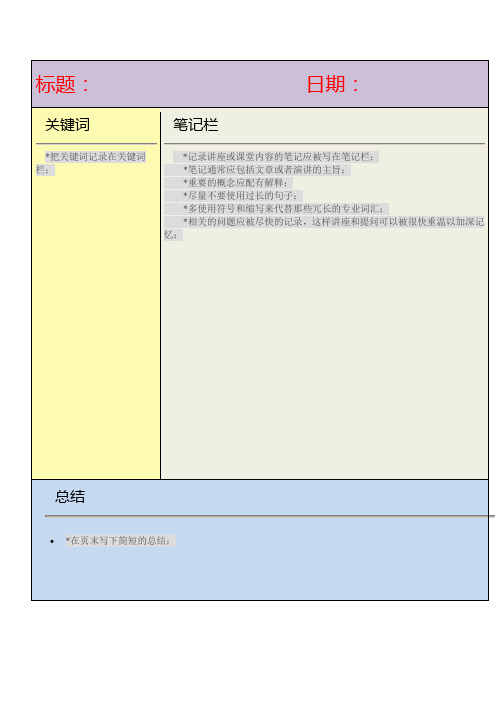
康奈尔笔记系统5R5R含义如下:1.记录(Record)。
2.简化(Reduce)。
3.背诵(Recite)。
4.思考(Reflect)。
5.复习(Review)。
康奈尔(Cornell)笔记记录法是于20世纪50年代由Cornell大学的Walter Pauk教授所设计的,如今它已经被广泛的使用。
Walter Pauk教授曾在他最畅销的《如何在大学中学习》(How to Study in College)一书中提倡这种方法,但是直到上一个十年这种方法才得以广泛传播。
方法概述将记笔记所用的纸张分成两栏:笔记栏(通常在右侧)和关键词栏(通常在左侧)。
笔记栏的宽度约为关键词栏的两倍。
在页面的下方留下5至6行,或约莫两英寸的空白区域。
*记录讲座或课堂内容的笔记应被写在笔记栏;*笔记通常应包括文章或者演讲的主旨;*重要的概念应配有解释;*尽量不要使用过长的句子;*多使用符号和缩写来代替那些冗长的专业词汇;*相关的问题应被尽快的记录,这样讲座和提问可以被很快重温以加深记忆;*把关键词记录在关键词栏;*在页末写下简短的总结;笔记栏1.记录:当你正在听课或演讲时,请使用一些简洁的语句来记录其中的重要信息,并将它们写在笔记栏。
2.提问:下课后,请尽快的根据笔记栏所记录的信息考虑好你的问题。
和你的笔记一样,记录下这些问题对于你今后的学习也将有很大的帮助。
3.复述:将你的笔记栏用纸遮住。
然后,仅仅看着你的提问或者列出的提示词用你自己组织的语言回答你的那些问题、数据或是提示词所指向的概念。
4.回忆:通过自问自答来回顾材料中的内容。
比如:“这些数据有着怎样的意义?他们基于什么原理?我该怎样应用这些?它们和我曾经学过的知识是怎样联系起来的?通过这些还可以引申出些什么?”5.复习:每周至少用十分钟的时间来温习之前的笔记。
写下问题有助于明确概念,理清关系,建立连续性,并可强化记忆。
此外,写下问题也对之后备试非常有帮助。
摘要:课后,使用这些位于页面底端的空白来总结整页笔记的重点。
康奈尔大学做笔记的方法,从此学习工作效率提高
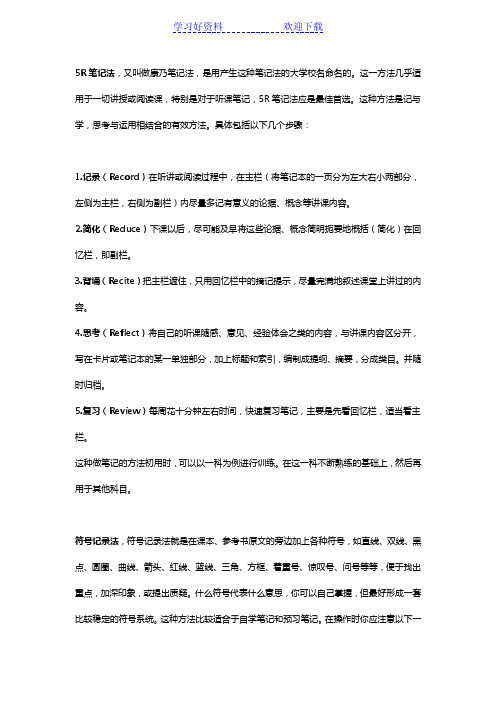
5R笔记法,又叫做康乃笔记法,是用产生这种笔记法的大学校名命名的。
这一方法几乎适用于一切讲授或阅读课,特别是对于听课笔记,5R笔记法应是最佳首选。
这种方法是记与学,思考与运用相结合的有效方法。
具体包括以下几个步骤:1.记录(Record)在听讲或阅读过程中,在主栏(将笔记本的一页分为左大右小两部分,左侧为主栏,右侧为副栏)内尽量多记有意义的论据、概念等讲课内容。
2.简化(Reduce)下课以后,尽可能及早将这些论据、概念简明扼要地概括(简化)在回忆栏,即副栏。
3.背诵(Recite)把主栏遮住,只用回忆栏中的摘记提示,尽量完满地叙述课堂上讲过的内容。
4.思考(Reflect)将自己的听课随感、意见、经验体会之类的内容,与讲课内容区分开,写在卡片或笔记本的某一单独部分,加上标题和索引,编制成提纲、摘要,分成类目。
并随时归档。
5.复习(Review)每周花十分钟左右时间,快速复习笔记,主要是先看回忆栏,适当看主栏。
这种做笔记的方法初用时,可以以一科为例进行训练。
在这一科不断熟练的基础上,然后再用于其他科目。
符号记录法,符号记录法就是在课本、参考书原文的旁边加上各种符号,如直线、双线、黑点、圆圈、曲线、箭头、红线、蓝线、三角、方框、着重号、惊叹号、问号等等,便于找出重点,加深印象,或提出质疑。
什么符号代表什么意思,你可以自己掌握,但最好形成一套比较稳定的符号系统。
这种方法比较适合于自学笔记和预习笔记。
在操作时你应注意以下一些准则:1.读完后再做记号。
在你还没有把整个段落或有标题的部分读完并停下来思考之前,不要在课本上做记号。
在阅读的时候,你要分清作者是在讲一个新的概念,还是只是用不同的词语说明同样的概念,你只有等读完这一段落或部分以后,才能回过头来看出那些重复的内容。
这样做可使你不至于抓住那些一眼看上去仿佛很重要的东西。
2.要非常善于选择。
你不要一下子在很多项目下划线或草草写上许多项目,这样会使记忆负担过重,并迫使你同一时刻从几个方面来思考问题,也加重你的思维负担。
5R记忆法
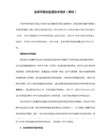
5R笔记法,这一法几乎适用于一切讲授或阅读课,特别是对于听课笔记,5R笔记法应是最佳首选。记与学,思考与运用相结合的有效方法。具体包括5个步骤:
1.记录(Record)。在听讲或阅读过程中,在主栏(将笔记本的一页分为左大右小两部分,左侧为主栏,右侧为副栏)内尽量多记有意义的论据、概念等讲课内容。
5.复习(Review)每周花十分钟左右时间,快速复习笔记,主要是先看回忆栏,适当看主栏。
2.简化(Reduce)。下课以后,尽可能及早将这些论据、概念简明扼要地概括(简化)在回忆栏,即副栏。
3.背诵(Recite)。据回忆栏中的摘记提示,尽量完满地叙述课堂上讲过的内容。
4.思考(Reflect)。将自己的听课随感、意见、经验体会之类的内容,与讲课内容区分开,写在卡片或笔记本的某一单独部分,加上标题和索引,编制成提纲、摘要,分成类目。并随时归档。
给学霸跪了康奈尔大学学霸记笔记方法介绍

给学霸跪了康奈尔大学学霸记笔记方法介绍今天小编要和大家分享一种记笔记的方法:5R笔记法,又叫做康奈尔笔记法,是用产生这种笔记法的大学校名命名的。
这一方法几乎适用于一切讲授或阅读课。
这种记笔记的方法可以帮助大家整理思路,边记边学边思考。
有了它,学习和复习的效率就能大大提升啦!一起向学霸看齐!一、5R笔记法5R笔记法,又叫做康奈尔笔记法,是用产生这种笔记法的大学校名命名的。
这一方法几乎适用于一切讲授或阅读课,特别是对于听课笔记,5R笔记法应是最佳首选。
这种方法是记与学,思考与运用相结合的有效方法。
具体包括以下几个步骤:1、记录(Record)。
在听讲或阅读过程中,在主栏(将笔记本的一页分为左大右小两部分,左侧为主栏,右侧为副栏)内尽量多记有意义的论据、概念等讲课内容。
2、简化(Reduce)。
下课以后,尽可能及早将这些论据、概念简明扼要地概括(简化)在回忆栏,即副栏。
3、背诵(Recite)。
把主栏遮住,只用回忆栏中的摘记提示,尽量完满地叙述课堂上讲过的内容。
4、思考(Reflect)。
将自己的听课随感、意见、经验体会之类的内容,与讲课内容区分开,写在卡片或笔记本的某一单独部分,加上标题和索引,编制成提纲、摘要,分成类目。
并随时归档。
5、复习(Review)。
每周花十分钟左右时间,快速复习笔记,主要是先看回忆栏,适当看主栏。
这种做笔记的方法初用时,可以以一科为例进行训练。
在这一科不断熟练的基础上,然后再用于其他科目。
二、符号记录法符号记录法就是在课本、参考书原文的旁边加上各种符号,如直线、双线、黑点、圆圈、曲线、箭头、红线、蓝线、三角、方框、着重号、惊叹号、问号等等,便于找出重点,加深印象,或提出质疑。
什么符号代表什么意思,你可以自己掌握,但最好形成一套比较稳定的符号系统。
这种方法比较适合于自学笔记和预习笔记。
在操作时你应注意以下一些准则:1、读完后再做记号。
在你还没有把整个段落或有标题的部分读完并停下来思考之前,不要在课本上做记号。
康奈尔笔记案例及模板(5R笔记法模板)
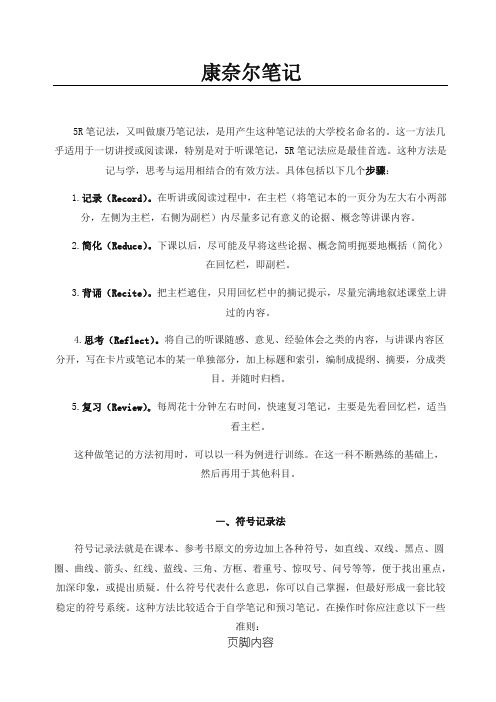
康奈尔笔记5R 笔记法,又叫做康乃笔记法,是用产生这种笔记法的大学校名命名的。
这一方法几 乎适用于一切讲授或阅读课,特别是对于听课笔记,5R 笔记法应是最佳首选。
这种方法是记与学,思考与运用相结合的有效方法。
具体包括以下几个步骤: 1.记录(Record)。
在听讲或阅读过程中,在主栏(将笔记本的一页分为左大右小两部分,左侧为主栏,右侧为副栏)内尽量多记有意义的论据、概念等讲课内容。
2.简化(Reduce)。
下课以后,尽可能及早将这些论据、概念简明扼要地概括(简化)在回忆栏,即副栏。
3.背诵(Recite)。
把主栏遮住,只用回忆栏中的摘记提示,尽量完满地叙述课堂上讲过的内容。
4.思考(Reflect)。
将自己的听课随感、意见、经验体会之类的内容,与讲课内容区 分开,写在卡片或笔记本的某一单独部分,加上标题和索引,编制成提纲、摘要,分成类目。
并随时归档。
5.复习(Review)。
每周花十分钟左右时间,快速复习笔记,主要是先看回忆栏,适当看主栏。
这种做笔记的方法初用时,可以以一科为例进行训练。
在这一科不断熟练的基础上,然后再用于其他科目。
一、符号记录法 符号记录法就是在课本、参考书原文的旁边加上各种符号,如直线、双线、黑点、圆 圈、曲线、箭头、红线、蓝线、三角、方框、着重号、惊叹号、问号等等,便于找出重点, 加深印象,或提出质疑。
什么符号代表什么意思,你可以自己掌握,但最好形成一套比较 稳定的符号系统。
这种方法比较适合于自学笔记和预习笔记。
在操作时你应注意以下一些页脚内容准则:1.读完后再做记号。
在你还没有把整个段落或有标题的部分读完并停下来思考之前, 不要在课本上做记号。
在阅读的时候,你要分清作者是在讲一个新的概念,还是只是用不 同的词语说明同样的概念,你只有等读完这一段落或部分以后,才能回过头来看出那些重复的内容。
这样做可使你不至于抓住那些一眼看上去仿佛很重要的东西。
2.要非常善于选择。
康奈尔大学做笔记的方法,从此学习工作效率提高
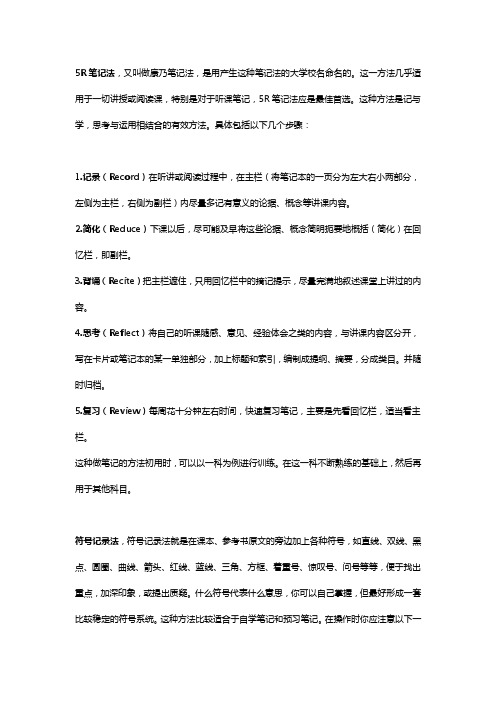
5R笔记法,又叫做康乃笔记法,是用产生这种笔记法的大学校名命名的。
这一方法几乎适用于一切讲授或阅读课,特别是对于听课笔记,5R笔记法应是最佳首选。
这种方法是记与学,思考与运用相结合的有效方法。
具体包括以下几个步骤:1.记录(Record)在听讲或阅读过程中,在主栏(将笔记本的一页分为左大右小两部分,左侧为主栏,右侧为副栏)内尽量多记有意义的论据、概念等讲课内容。
2.简化(Reduce)下课以后,尽可能及早将这些论据、概念简明扼要地概括(简化)在回忆栏,即副栏。
3.背诵(Recite)把主栏遮住,只用回忆栏中的摘记提示,尽量完满地叙述课堂上讲过的内容。
4.思考(Reflect)将自己的听课随感、意见、经验体会之类的内容,与讲课内容区分开,写在卡片或笔记本的某一单独部分,加上标题和索引,编制成提纲、摘要,分成类目。
并随时归档。
5.复习(Review)每周花十分钟左右时间,快速复习笔记,主要是先看回忆栏,适当看主栏。
这种做笔记的方法初用时,可以以一科为例进行训练。
在这一科不断熟练的基础上,然后再用于其他科目。
符号记录法,符号记录法就是在课本、参考书原文的旁边加上各种符号,如直线、双线、黑点、圆圈、曲线、箭头、红线、蓝线、三角、方框、着重号、惊叹号、问号等等,便于找出重点,加深印象,或提出质疑。
什么符号代表什么意思,你可以自己掌握,但最好形成一套比较稳定的符号系统。
这种方法比较适合于自学笔记和预习笔记。
在操作时你应注意以下一些准则:1.读完后再做记号。
在你还没有把整个段落或有标题的部分读完并停下来思考之前,不要在课本上做记号。
在阅读的时候,你要分清作者是在讲一个新的概念,还是只是用不同的词语说明同样的概念,你只有等读完这一段落或部分以后,才能回过头来看出那些重复的内容。
这样做可使你不至于抓住那些一眼看上去仿佛很重要的东西。
2.要非常善于选择。
你不要一下子在很多项目下划线或草草写上许多项目,这样会使记忆负担过重,并迫使你同一时刻从几个方面来思考问题,也加重你的思维负担。
- 1、下载文档前请自行甄别文档内容的完整性,平台不提供额外的编辑、内容补充、找答案等附加服务。
- 2、"仅部分预览"的文档,不可在线预览部分如存在完整性等问题,可反馈申请退款(可完整预览的文档不适用该条件!)。
- 3、如文档侵犯您的权益,请联系客服反馈,我们会尽快为您处理(人工客服工作时间:9:00-18:30)。
Cornell Note Taking Method The Cornell note taking system, developed by former Cornell professor Walter Pauk features three areas. One area is for note taking, one for review notes, and one for summarizing.
Many times note taking is one of the most difficult things for a student to do effectively. It can be difficult for students to know what to write down, what is important or pertinent information, or how to structure their notes so they are easy to study from in the future. By taking the time to understand why we take notes, how best to do so, and how to use them, we are able to improve our ability to make them truly useful. Notes can be one of the strongest tools a student has in their academic experience. Before attempting to take notes, consider the following questions: What is effective note taking? How can I take good notes in class or from written texts? Is it different for each? What is the overall goal of my note taking? How do I study and what should I include in my notes to help this process? How is the class that I am taking taught and how should I take notes based on this? Why do we take notes? To summarize. To highlight important information. Most importantly, to review and study from later.
This format provides the perfect opportunity for following through with the 5 R's of note-taking: Record During class, record in the main “note-taking” column as many meaningful ideas as you can. Reduce As soon after as possible, summarize these facts and ideas concisely in the Cue Column. Summarizing clarifies meanings and relationships, reinforces continuity, and strengthens memory.
Recite Cover the Note Taking Area, using only what you can see in the Cue Column, recite and explain the information in your own words. Then, verify what you have said by looking at the Note-taking column. Reflect Reflect about the information by summarizing the contents of each page. Write your summary in the space at the bottom of each page of notes. Reviewing through summarizing will help prevent information from being soon forgotten. Review Spend a few minutes each day to quickly review your notes; you will retain most of what you have learned
Subject: Notetaking_ Main Ideas Cornell notes
• • • • • •
Details Can be used to provide an outline of a chapter, lecture, class discussion, etc. Organized by main ideas and details. Can be as detailed as necessary. Sequential-- take notes in an orderly fashion. After class, write a summary of what you learned to clarify and reinforce learning and to assist retention. Can be used as study tool: 1. List concepts on the left side. 2. Identify the concept and provide details on the right side. Can be used to provide a "big picture.” Organized by main ideas and sub-topics. Limited in how much detail you can represent. Can be used as a study tool -- to get a quick overview and to determine whether you need more information or need to concentrate your study on specific topics.
Semantic map or web
• • • •
Summary: There are a couple of ways that you can take notes. The Cornell method is best when the information is given in a sequential, orderly fashion and allows for more detail. The semantic web/map method provides a "big picture" when you're previewing materials or getting ready to study for a test.
Adaptation of Cornell Notes: In a spiral notebook or three-ring binder, reserve the back of notebook paper (to the left of the center binding) for student-created notes from reading the textbook. This page can be divided so that a mid column can contain questions or thoughts that need clarification by the teacher during class. The right hand side of the notebook can be reserved for notes taken during class lessons and discussions.
Reading Notes
Center Column
Class Notes
Discussion questions
。
